
We were in the Galápagos Islands and we kept noticing these beautiful trees with interesting roots. Lo and behold, we were seeing mangroves! We learned that there were four principal types, and on Isabela Island in Puerto Villamil we encountered all four in front of our hotel, Hotel Sol (lat -0.9585, long -90.9645 or 0d 57’ 31” S, 90d 57’ 52” W) on December 31st , 2011. What better way is there initiate the Binomen Art series?
Rhizophora mangle - Red Mangrove is the most common mangrove, easily recognized by its stilt roots and shiny, waxy leaves. It is a true mangrove. The generic name, Rhizophora, comes from the Greek words rhiza meaning “root” and phoros meaning bearing and referring to the stilt-roots. Mangle is the Spanish name for mangrove or a thicket.
Rhizophora mangle - Red Mangrove, Puerto Villamil, Isabela Island, Galápagos


Rhizophora mangle - Red Mangrove Propagules and Spelling The Name in Sand

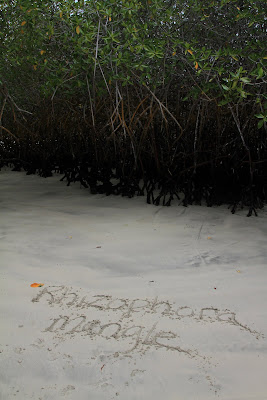
Avicennia germinans - Black Mangrove takes its common name from its grey-black bark. Another distinctive aspect is the cluster of fruits that look like lima beans with fuzzy jackets. The generic name honors the Persian physician Avicenna (980 - 1037). The specific name, germinans, is the Latin term meaning to germinate, but referring to what characteristic of this plant? After a rain shower, as shown in the before and after pictures, the seeds did look very ready to sprout.
Avicennia germinans - Black Mangrove, Puerto Villamil, Isabela Island, Galápagos
Letters spelled out with seeds and twigs
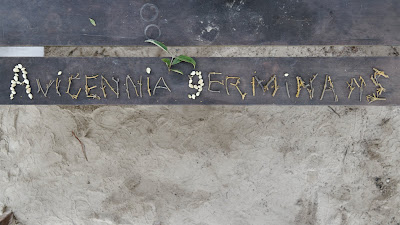
Avicennia germinans - Black Mangrove – After a Day and a Rain Shower and the Word is Sprouting

Avicennia germinans - Black Mangrove – Sprouting “A”
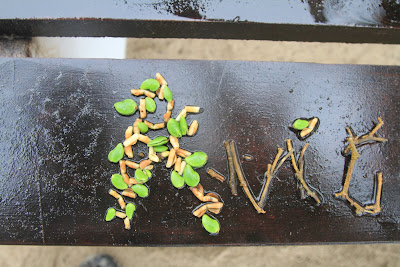
Avicennia germinans - Black Mangrove, the Tree that Provided the Lettering Material
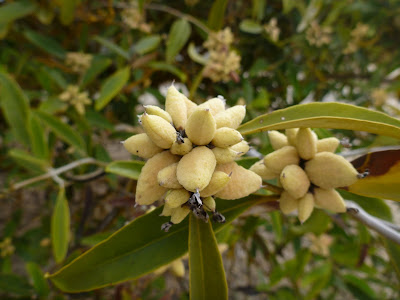
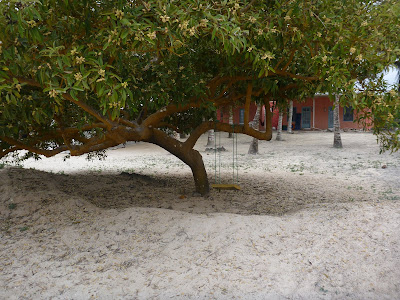

Conocarpus erectus - Button Mangrove is a mangrove that is typically found on the back of sandy beaches and that is exactly where we saw this one. It is easy to distinguish by is rounded fruits that look like buttons. The generic name, Conocarpus, comes from the Greek konos meaning “cone” and carpos meaning “fruit” referring to the cone-shaped fruit.
Conocarpus erectus – Button Mangrove, Puerto Villamil, Isabela Island, Galápagos
Letters spelled out with collected “buttons”
 Conocarpus erectus – Button Mangrove, the Buttons Up Close on the Tree That Provided the Lettering Material
Conocarpus erectus – Button Mangrove, the Buttons Up Close on the Tree That Provided the Lettering Material

Laguncularia racemosa - White Mangrove’s generic name comes from the Latin laguncula meaning “small flask or bottle”. This Laguncularia racemosa fact sheet form the University of Florida states that laguncularia refers the shape of the white mangrove’s fruit and that the specific name, racemosa, or “cluster” refers to the growth pattern of the fruits in racemes.
Laguncularia racemosa – White Mangrove, Puerto Villamil, Isabela Island, Galápagos
Letters spelled out with seaweed and found beach objects

Laguncularia racemosa, Leaves and Flowers and Small Plant on a Beach
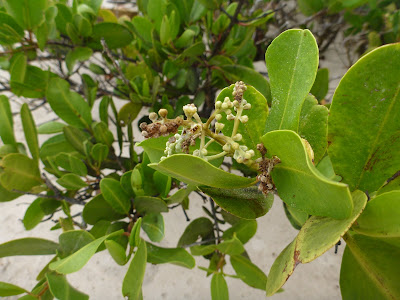
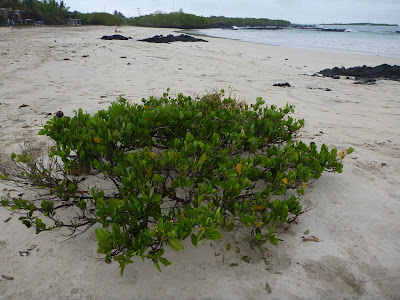
The approximate order of mangroves you can expect to see starting from the water’s edge and walking inland is red, white, black, and button mangrove. Red, black, and white mangroves reproduce using propagules which are new plants that grow on the parent and then become detached. Red mangrove propagules look like long beans and these we did see. We did not see the propagules for black and white mangrove. For more information, see Reproductive Strategies of Mangroves. The propagules are perfect for dropping in the water and floating away to root on some distant beach.
Comparison of Mangrove Leaves, Puerto Villamil, Isabela Island, Galápagos
From Left to Right: Button, White, Black, and Red


No comments:
Post a Comment
All comments are moderated. If your comment doesn't appear right away, it was likely accepted. Check back in a day if you asked a question.